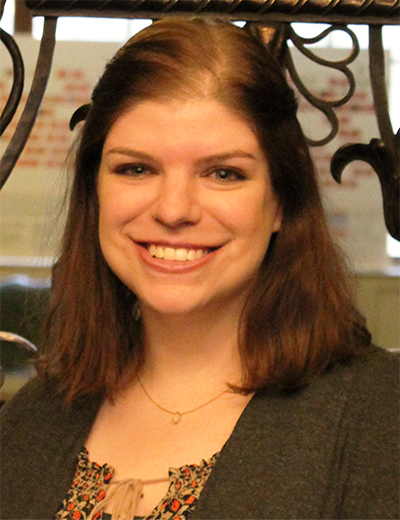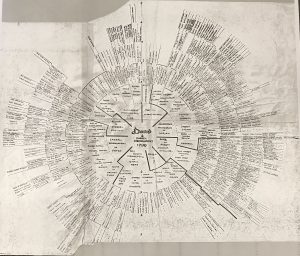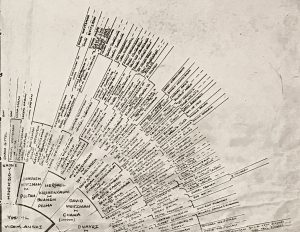May is Jewish Heritage Month, so in its honor I decided to look into my own Jewish heritage.
Even though I work at a genealogical society, I always felt that it was a worthless pursuit to try to trace my genealogy back many generations. My great-grandparents and some of my great-great-grandparents were the ones who immigrated to the United States in the 1910s and 1920s. Due to language differences, various names, changing borders, and not even knowing exactly where they were from (“somewhere in Russia” or “maybe Bialystock,” my grandparents would say), I never really gave it a shot.
One day, however, my mom showed me a family tree tracing my maternal grandmother’s family. The family tree centers on a David and Shaneh Vidomlansky, who were married in 1790, and then circles out to show their descendants.
As many Jewish people likely do, I had always wondered if any of my family had died in the Holocaust. Whenever I asked my grandparents about it, they assumed their aunts and uncles who stayed in Eastern Europe were killed. So with this family tree in hand, I decided to investigate.
Looking at the family tree, there is clearly a branch of my family that died off. Simchech and Pelta Weitzman – my great-great-grandmother’s brother and sister-in-law – had eight children. Some of these children had their own children, but aside from one son, David, whose branch went on for a few generations, Simchech and Pelta’s other children’s branches simply ended. I figured this was a place to start.
Using Ancestry.com, I learned that my great-grandfather Samuel Kirshenbaum listed Brest, Russia (present-day Belarus) as his place of birth on his World War II draft registration card. So I had some sort of geographic reference. Using the Yad Vashem Central Database of Shoah Victims’ Names, I started searching by name. I knew with different spelling and languages, this might not be easy. I did find some matches for a Bluma Kaplan, but was unable to verify if it was the right Bluma Kaplan. I did notice that two of the Blumas had Kamieniec Litewski, Poland (now in Belarus) listed as a place of birth or residence. Upon further research, I learned that Kamieniec Litewski is in the Brest region of Belarus. Was I onto something?
Kamienec Litewski had a Jewish presence beginning in the early sixteenth century. In 1891, its Jewish population was 2,722 (76 percent of the town’s total population). The Jewish community suffered during World War I, with Russians and Hungarians pillaging the town and German soldiers pushing them into forced labor. In 1921, the Jewish population shrank to 1,902. In 1941, in the midst of World War II, 100 local Jews were murdered for alleged ties to Communists. Most others were sent to the Pruzhana Ghetto in 1941 and subsequently deported to Auschwitz in February 1943. Others were confined to a local ghetto and deported to Treblinka in November 1942.[i]
This time, in the Yad Vashem database, instead of searching for names I searched for Kamienec Litewski and soon found many names from my family. I noticed that the source of this information for these records were from Pages of Testimony submitted by a man named Azriel Kaplan. Pages of Testimony are records submitted by survivors, family members, or friends of those murdered in the Holocaust. They contain names, biographical information, and sometimes photographs.
Who was Azriel Kaplan? Each Page of Testimony lists the submitter’s relationship to the victim, so using this information, I was able to deduce that Azriel Kaplan is my second cousin twice removed, listed as Israel Kaplan (son of Bluma and Label Kaplan, grandson of Simchech and Pelta Weitzman) on my family tree. Sadly, he submitted Pages of Testimony for much of his family, including his mother, aunts, uncles, nieces, nephews, wife, and children. He submitted Pages of Testimony for:
- His mother, Bluma Kaplan: born in 1875 in Kamieniec Litewski, a housewife; died in the Warsaw Ghetto
- His aunt, Gitil (Gittel) Winszten: born in 1885 in Kamieniec Litewski, a housewife; died in the Warsaw Ghetto
- His aunt, Sonia (Surcha) Rozenfield: born in 1885 in Kamieniec Litewski, a housewife; died in the Warsaw Ghetto
- His uncle and Sonia’s husband, Abram Rozenfeld: born in 1890 in Kazimierz Dolny, Poland, a journalist; died in the Warsaw Ghetto
- His aunt, Roza (Rayziel) Friszberg: born in 1890 in in Kamieniec Litewski, a housewife; died in the Warsaw Ghetto
- His aunt, Mina (Minnah) Wolpin: born in 1909 in Kamieniec Litewski, a housewife; died in the Warsaw Ghetto
- His uncle and Mina’s husband, Israel (Yisroel) Wolpin: born in 1905 in Szeldlec, Poland, a merchant; died in the Warsaw Ghetto
- His sister, Chawa (Chava) Cukerman: born in 1912 in Wisokie, Poland, a housewife; died in the Warsaw Ghetto
- His brother-in-law and Chawa’s husband, Szlomo Cukerman: born in Wisokie, Poland, a clerk; died in the Warsaw Ghetto
- His nephew and Chawa’s son, Avraham Cukerman: age 4; place of death unknown
- His niece and Chawa’s daughter, Simkha Cukerman: age 2; place of death unknown
- His brother, Abram Kaplan: born in 1917 in Wisokie, Poland, a clerk; died in Treblinka
- His brother, Sender Kaplan: born in 1912 in Wisokie, Poland; died in Treblinka
- His sister-in-law and Sender’s wife, Luba Kaplan: born in 1917 in Wisokie, Poland, a housewife; died in Treblinka
- His nephew and Sender’s son, Arie Kaplan: age 1, born in Wiskokie, Poland; place of death unknown
- His wife, Szejna Kaplan: born 1906 in Diwin, Poland, a housewife; died in the Warsaw Ghetto
- His son, David Kaplan: born in 1925; place of death unknown
- His daughter, Pola Kaplan: born in 1930; place of death unknown
An uncle, David Weitzman, born in 1882, and his wife Annie (Chankeh) left for the United States in 1902, thereby escaping the fate of David’s siblings. They settled in the Bronx, New York, and David worked as a cigar stand keeper. The fate of Azriel’s other aunts, uncles, and cousins is unknown. Azriel also submitted further Pages of Testimony for his wife’s family.
I had always assumed that family members – no matter how distantly related – were murdered in the Holocaust. But actually seeing their names among the dead stirred a lot of emotions in me: sadness, anger, bewilderment. Knowing that Azriel Kaplan survived to see so much of his family – including his wife and his two young children – killed was devastating. I don’t know what happened to Azriel – where he was sent during the Holocaust, where he went after the war ended, how long he lived – but I hope he was able to find happiness after such brutal suffering.
Note
[i] “Kamienec Litewski,” in The Encyclopedia of Jewish Life Before and During the Holocaust, ed. Shmuel Spector (New York: New York University Press, 2001), 592.
Share this:

About Lindsay Murphy
Lindsay Murphy began her work at Wyner Family Jewish Heritage Center at the New England Historic Genealogical Society in October 2014 as an intern and joined the staff in August 2015. As Collections Archivist, Lindsay manages all processing projects and is responsible for reviewing and encoding finding aids. She received a B.A. in History from the University of North Carolina at Chapel Hill and a M.S. in Library and Information Science with a concentration in Archives Management from Simmons College. She is a member of the Society of American Archivists and the New England Archivists.View all posts by Lindsay Murphy →

